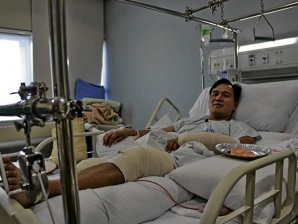MANILA, Philippines—The justice department on Thursday filed multiple murder charges against 13 policemen for the killing of a suspected gambling lord and his companions in Atimonan town, Quezon province, but threw out the same charges against another police officer and 11 soldiers.
The charges against Supt. Hansel Marantan and 12 policemen for the Jan. 6 killing of “jueteng” (illegal numbers game) operator Vic Siman and 12 others were filed in the Regional Trial Court in Gumaca town, Quezon province.
The Department of Justice (DOJ) dismissed the multiple murder complaint against former Calabarzon police chief Supt. James Andres Melad and 11 soldiers for lack or insufficiency of evidence.
The filing of the cases came six months after the National Bureau of Investigation filed multiple murder charges against 25 policemen and soldiers for the killings.
Obstruction of justice
In a resolution, the DOJ prosecutors recommended multiple murder charges against Marantan, Supt. Ramon Balauag, Chief Insp. Grant Gollod, Senior Insp. John Paolo Carracedo, Senior Insp. Timoteo Orig, SPO3 Joselito de Guzman, SPO1 Carlo Cataquiz, SPO1 Arturo Sarmiento, PO3 Eduardo Oronan, PO2 Nelson Indal, PO2 Al Bhazar Jailai, PO1 Wyran Sardea and PO1 Rodel Talento, aka Rodel Tolentino.
The panel dismissed the multiple murder charges against Melad, Lt. Col. Monico Abang, Capt. Erwin Macalinao, Lt. Rico Tagure, Cpl. Rogelio Tejares, Pfc. Ricky Jay Borja, Pfc. Michael Franco, Pfc. Gilm Gallego,
Pfc. Melvin Lumalang, Pfc. Alvin Roque Pabon, Pvt. Emergin Barrete and Pvt. Marc Zaldy Docdoc.
It also dismissed the obstruction of justice complaint against seven policemen—Chief Insp. Zaide Abrera, Police Insp. Dickson Mercado, SPO1 Meldy Arojo, SPO1 Analiza Burcelango, PO3 Nestor Abuan, PO3 Archie Avila and PO2 Bayani Gonzales.
But it filed obstruction of justice charges against Carracedo and Tagure.
Evidence clear
The panel said the evidence was clear that all the accused policemen—except for Melad, who was not at the scene of the shooting—fired on Siman and his group, who were on board two Mitsubishi Monteros.
Although several people fired shots at the Siman group, the act was considered “independent but in concert with each other.”
The panel said the policemen, except for Melad, “conspired and confederated with each other to eliminate the victims.”
“The plan to eliminate the group of Vic Siman became apparent when respondent Marantan, together with respondents Gollod and Balauag, put up a three-layered checkpoint, which … was highly irregular and nonconforming to common and established procedures on checkpoints,” the panel said.
It said the NBI provided “credible” evidence that some of the victims were shot at close range and that forensic examinations showed there was no possibility the Monteros’ occupants could have fired from their vehicles.
The panel also noted that the actions of the policemen after the shooting “strongly signify their intention to muddle up the evidence … to mislead and/or influence the result of the investigation, and show their earlier premeditated plan to kill the occupants of the Monteros.”
The complaint against Melad was dismissed because the evidence failed to establish his participation in the conspiracy. He was not present during the shooting, said the panel, thumbing down claims that Melad knew of the plan to kill Siman and his companions.
Also, Melad did not know the identity of the targets of the checkpoints because Marantan had only told him there was an armed group being pursued without identifying them.
“The concealment of the identities of the targets is a manifestation that Marantan did not want Melad to know about their operation,” it said.
Soldiers bewildered
The case against the soldiers was dismissed because the panel said the evidence did not show they were part of the conspiracy to eliminate the victims.
“In fact, respondents—AFP were … bewildered when, after the shooting incident, respondent Carracedo started taking the firearms of the victims and firing them into the air at different directions … manifest(ing) that their knowledge regarding the plan to kill the victims was limited, if they had any knowledge at all,” the panel said.
The panel said while the soldiers did fire at the victims, it was because they were asked to support the operation of the police, who “dictated” the operation.
“Perhaps if they were in conspiracy with the police elements, they could have just easily kept to themselves what respondent Carracedo did. Their electing to reveal the irregularity indicates … a clear conscience on the part of these AFP personnel,” it said.
Superior strength
Suspicion that the soldiers were in cahoots with the policemen was further erased when they admitted firing their guns, unlike their counterparts.
The panel concluded that the killing of the victims indicated “evident premeditation, [use] of superior strength [and] treachery.”
Treachery was evident when the policemen “employed the checkpoint as a means to execute the crime of murder, giving the victims no opportunity to defend themselves,” the panel said.
“The sheer number of bullets that the respondents fired indicates that the police took advantage of their superior strength in terms of firearms and manpower,” it said.
The panel said obstruction of justice charges should be filed against Carracedo and Tagure.
Glass windows broken
It supported the NBI claim that Carracedo tampered with the crime scene when he willfully fired the firearms of the victims in the air before returning them to where he got them.
Tagure was charged because he broke the glass windows of the Monteros and opened the door of one of the vehicles so Carracedo could take the firearms.
The case was raffled off to Presiding Judge Maria Chona Pulgar-Navarro of Branch 61.—With a report from Sonny Mallari, Inquirer Southern Luzon
